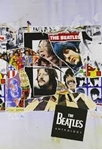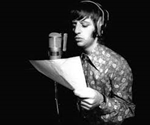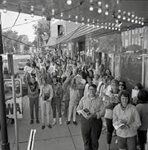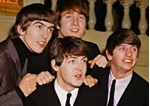- Register
- Log in to Tune-In
- Wishlist (0)
-
Shopping cart
(0)
You have no items in your shopping cart.
Beatles News

The Beatles never played a lot of their music live, considering the Fab Four called it quits for good just a few years after they retired from touring in 1966. It’s a shame, but we’ve been lucky enough to hear a few Beatles songs performed for the first time by each former member after they kicked off their solo careers.
That being said, quite a few songs still haven’t gotten a live performance. One such song would be the single “The Ballad Of John And Yoko” from 1969. This song didn’t make it to any album. Rather, it was released as a B-side to the May 1969 single “Old Brown Shoe”.
“The Ballad Of John And Yoko” was written by John Lennon and explores the pair’s famous wedding. Lennon wrote the song while he and his new wife were enjoying their honeymoon in Paris, France. It describes their famous “bed-in” in Amsterdam and performance art stunt to demonstrate “bagism”. Lennon even said that the song was less of a love song and more of “a piece of journalism.” The song also happened to be the very last no. 1 single in the UK until the late-released track “Now And Then” came out in 2023.
So, is details

Shortly after the Beatles parted ways in 1970, George Harrison was already well into his third album, a nostalgic retreat into past influences and a new beginning as a solo artist. Harrison’s triple album All Things Must Pass was his first album since the Beatles’ split and became the most successful solo release by a member of the band at the time, going to No. 1 worldwide, including in the UK and on the Billboard 200.
The first single from All Things Must Pass, “My Sweet Lord,” released with the B-Side, and another hit for Harrison, “What Is Life,” met a similar fate, topping the charts and giving Harrison his first No. 1 single as a solo artist. Despite the success of the track, it wouldn’t be long before Harrison found himself in a legal battle over the song and was accused of plagiarizing a 1960s hit.
Months after the release of “My Sweet Lord,” Bright Tunes Music sued Harrison in 1971, claiming that the song infringed the copyright of the Ronnie Mack-penned “He’s So Fine,” which became a hit for the girl group the Chiffons in 1963.
The lawsuit claimed that “My Sweet Lord” sounded too similar to the Chiffons’ h details

Almost 29 years after airing on TV and its later expansion on VHS/DVD, The Beatles Anthology remains an epic documentary series.
I became a fan of The Beatles through watching The Beatles Anthology during its three-night ABC broadcast in 1995. It would lead to both Sgt. Pepper’s Lonely Hearts Club Band and Abbey Road becoming the first CDs in my collection. I would also pick up a guitar for the first time, later dropping the trumpet. In college, I took a piano course for the same reason but never quite mastered it. Of course, there’s the time that I saw Paul McCartney in concert back in 2011. That’s my Beatles story in a nutshell but none of it happens without ABC becoming A Beatles C. Fun fact: I came into the series because of all the ABC stars promoting it at the time so you can blame the misleading marketing for my becoming a fan.
While the initial broadcast ran about six hours, the expanded DVD is even longer. The eight DVD volumes span 1940 through their breakup after recording Abbey Road. On top of that, there’s another disc with 81 minutes of special features. All of the music is remastered for 5.1. I took in all of it in just over a 24-hour period prior to the Olympics kicking of details

In 1964, after playing to a staggering 45% of American households on “The Ed Sullivan Show” in February, the band embarked upon a chaotic tour of North America. The dates included a Sept. 5 show at Chicago’s International Amphitheatre, 60 years ago this week.
“It’s hard to understand how it was before the internet, but there was a thing called word of mouth,” says Beatles historian Martin Lewis. “The Beatles became successful because friends told friends. They said, ‘Have you heard this? It’s astonishing.’ ”
On the podcast “The Excerpt,” Lewis talked recently about how The Beatles went from being virtually unknown in the U.S. in 1963 to global icons in 1964. Here are a few highlights:
Q. What was happening in the American music scene when The Beatles toured the country in 1964?
A.The audience was still in the 1950s. They were still in that gray Eisenhower decade, but The Beatles were in 3D Technicolor … just giddy and optimistic and exuberant with their own energy, their enjoyment of music. And America was sorely in need of that authenticity and that expression of youthful vitality.
Q. What role did The B details

Paul McCartney and John Lennon loved to get weird with their songwriting, and it’s part of what made The Beatles so charming. However, there are quite a few lyrics from their songs that just don’t make any sense. Let’s take a look at some of the strangest Beatles lyrics and what they actually mean. This isn’t an exhaustive list; there are quite a few head-scratching lines in The Beatles’ discography. We just think these five songs are worth revisiting.
1. “I Am The Walrus”
“I am the eggman / They are the eggmen / I am the walrus / Goo goo g’ joob.”
“I Am The Walrus” is one of the Fab Four’s most surreal and seemingly nonsensical songs. Could there be a deeper meaning behind these particular lyrics? Lots of fans have tried interpreting the lyrics, and some believe it’s all about the cycle of human life from egg to… walrus? All we know for sure is that Lennon wanted to write a very obscure and bizarre song, so he wrote this one. We’ll likely never know what it’s about; if it’s about anything at all.
2. “Dig A Pony”
“Oh now / I roll a stoney / Well you can imitate details

The new documentary One to One: John & Yoko is ostensibly about John Lennon and Yoko Ono‘s move to New York City in the ’70s and their 1972 One to One concerts, which were Lennon’s only post-Beatles full-length performances. But according to People, the doc also shows Ono airing her grievances about how she was treated because of her relationship with Lennon.
In one portion of the film, People reports, Ono is seen giving a speech at the First International Feminist Conference in 1973, where she told the crowd that after she and Lennon got together, “the whole society started to attack me, and the whole society wished me dead.”
In another part of the documentary, Ono says that because she was made a scapegoat for the breakup of The Beatles, she received letters while pregnant that read, “I wish you and your baby would die,” and was even sent a voodoo doll stuck with pins.
According to People, in the film Ono also expresses disappointment over the fact that, she claims, George Harrison, Ringo Starr and Paul McCartney never “set the record straight” about the fact that she wasn’t the reason the band broke up.
Source: wdrv.com

Plenty of Beatles songs never made it to the stage. Whether it’s because the band retired from touring before the song could get a proper performance or some other reason, plenty of fan favorites never got to be experienced live in concert.
One such song is the 1968 track “Good Night” from the band’s self-titled album, also known as the White Album. “Good Night” is one of the Fab Four’s most famous closers. It is the last song on that very album and one of very few that features Ringo Starr as the lead singer. In fact, he’s the only Beatle featured on the song, period. Starr sings his heart out against an orchestral arrangement conducted by the famed English composer George Martin. So, is there a deeper reason as to why The Beatles never performed this incredible closing song live?
The answer to this question is pretty simple: They had retired from touring long before the song was released. Specifically, the Fab Four quit touring in 1966. However, there is another question worth posing: Why didn’t Starr perform the song live throughout his solo career?
“Good Night” wasn’t written by Starr. It was originally wr details

Paul McCartney wanted the Beatles to star in an anti-Vietnam War film at the height of their fame, a new book has revealed.
Philosopher Bertrand Russell had pleaded with the singer and bass guitarist “to do something positive” with the Fab Four’s global following and make a political movie a year after the band’s second big screen outing Help.
But the secret 1966 film project was shelved after thriller writer Len Deighton failed to convince Sir Paul, now 82, that remaking the First World War musical Oh! What a Lovely War was the right vehicle for his stand against US intervention in South East Asia.
In Deighton’s 1966 script, the Fab Four would have played members of the doomed Smith family, who feature in the musical and unwittingly volunteer for the hell of the trenches. By then the Beatles had made two films, A Hard Day’s Night in 1964 and Help in 1965. So the third film would have been at the height of Beatlemania.
Writing in his new book, With The Beatles, Patrick Humphries reveals the idea was born in the summer of 1966 when McCartney met 94-year-old anti-war activist Russell in London.
“Russell had tried to convince Paul to do something pos details

The Beatles quit touring for good in 1966, and many of the songs from later releases never got a proper Fab Four performance. That being said, each respective member of The Beatles went on to perform a number of those post-Beatles songs during their solo runs. But surprisingly, there’s one hit track that never got a performance; not even from the man who wrote it.
That song would be “Martha My Dear” from the band’s 1968 self-titled album. The track was written by Paul McCartney and is a heartfelt tribute to his beloved sheepdog, Martha. Some have interpreted the song as a reference to his public breakup with Jane Asher, notably with the lyrics “Don’t forget me”. The lyrics “Help yourself to a bit of what is all around you” is seen as a dig at a potential alleged affair Asher had while McCartney was traveling with The Old Vic Theatre.
However, McCartney has never verified these claims. He’s also never performed the song live. Why Paul McCartney Never Performed “Martha My Dear” Live?
“Martha My Dear” is a major fan-favorite among Beatles superfans and casual listeners alike. The band’s contemporaries and other a details

John Lennon and Yoko Ono's move to New York City in the early 1970s is the subject of the new documentary One to One: John & Yoko
The film will explore the backlash Ono faced from Beatles fans upon entering into a relationship with Lennon
"Society suddenly treated me as a woman who belonged to a man who is one of the most powerful people in our generation," she says in the documentary. A new documentary is revisiting the difficult road Yoko Ono faced when she fell in love with John Lennon in the late 1960s.
One to One: John & Yoko focuses on never-before-seen material of the high-profile couple as they uproot their life in England to move to New York City in 1971, where a changing American culture collides with the pair’s desire to do good in the world.
In one moving section of the film, Ono gives a speech at the First International Feminist Conference, which took place in 1973. During the emotional address, Ono, then 40, detailed the harsh way she was treated by society after she first started dating Lennon and how a constant barrage of criticism chipped away at her self-confidence.
When Ono and the former Beatle first met in 1966, she was already established as a success details

George Harrison gained a reputation as being a seeker of sorts, constantly searching for insight about the way to live his life under the strange circumstances of being a worldwide celebrity. As it happens, he was also actively researching the proper way to leave this life.
The song “Art of Dying,” which was released on Harrison’s incredible triple album All Things Must Pass in 1971, expresses some of the former Beatle’s ideas on the subject, many of which were sourced from his study of Indian religious beliefs. It’s an incredibly nimble lyric that elucidates a weighty subject with smarts and feeling.
A Song Years in the Making
Many of the songs that appeared on All Things Must Pass were begun when Harrison was still a member of The Beatles. In the case of “Art of Dying,” he had begun writing it all the way back in 1966, some five years before he’d get a chance to release it once he had gone solo. Early versions of the song even contained references to Beatles’ manager Brian Epstein.
The title of “Art of Dying” is telling, because that’s essentially what Harrison is trying to communicate to his audience. As he explained in his b details

The band performed two sold-out shows on Sept. 3, 1964. Now, the fairgrounds are bringing the magic back with a tribute band, an art installation, and more. The Beatles toured the United States and Canada between August 19 and September 20, 1964.
What was life like in 1964? College students from across the US traveled to Mississippi to participate in Freedom Summer, the Ford Mustang debuted, Muhammad Ali became the world heavyweight champion... and The Beatles played at the Indiana State Fair.
In honor of the 60th anniversary of the two sold-out shows played on Sept. 3, 1964, the fairgrounds are celebrating all things Fab Four once more. The festivities on Tuesday, Sept. 3 include:
The unveiling of an art installation
A listening session of the original audio from the 1964 performance
A live performance of the original setlist by cover band 1964 The Tribute
An encore performance of The Beatles’ greatest hits
Merchandise + themed food and beverage options, such as “Hard Day’s Flight” “and “Yellow Submarine Sandwich”
Tickets are still available for $5, the same price thousands of screaming fans originally paid to see the band & details

Ann Arbor wasn’t immune to the fanatical craze sweeping the nation 60 years ago when the Beatles arrived in the United States.
With the British Invasion underway, Beatlemania struck Tree Town in 1964.
That was on full display that August as hundreds of enthusiastic teenagers lined up along State Street outside the State Theatre downtown for tickets to see the Beatles’ first feature film, “A Hard Day’s Night.”
“I love the Beatles” was among messages in the crowd, along with posters of the rockers from Liverpool, England, known for hits such as “She Loves You” and “I Want to Hold Your Hand.”
Beatlemania in Ann Arbor
Enthusiastic teenagers line up along State Street outside the State Theatre in downtown Ann Arbor for tickets to see the Beatles film "A Hard Day's Night" in August 1964.Duane Scheel | Ann Arbor News archives courtesy of OldNews.AADL.org
Ann Arbor News reporter Dave Bishop and photographer Duane Scheel were there to document the excited scene as tickets went on sale two weeks ahead of the movie’s Sept. 3 opening at the theater. The crowd filled the sidewalk down to Washington Street and was estimated to details

In interviews Paul McCartney gave during the promotion of his album Band on the Run, he stated that “Jet” was the name of a black Labrador puppy. In later years, he told the story of how it was the name of a Shetland pony he owned. Both stories could be true, but either way, it doesn’t make a difference to the meaning of the song “Jet’s” lyrics. McCartney also talks about his father-in-law in relation to the words. David Bowie’s “Suffragette City” played a role as well. Dress it all up with a cool saxophone riff and some fist-pumping, arena-rock hooks and you’ve got one of McCartney’s most memorable singles. Let’s take a look at the story behind “Jet” by Paul McCartney & Wings.
Jet, Jet
Jet, I can almost remember their funny faces
That time, you told them you were going to be marrying soon
And Jet, I thought the only lonely place was on the moon
Jet the Puppy
McCartney wasn’t sure there was a single on his 1973 album Band on the Run. Al Coury, head of marketing at Capitol Records, convinced him to edit “Jet” down to a length more condusive to FM radio play. In 1973, McCartney told author details

Already one of history's greatest rock bands, The Beatles were even more than the sum of their parts. In the wake of the band's legendary 1960s run came a number of high-profile solo releases from each individual member. That includes Ringo, whose eponymous 1973 album peaked at #2 on the U.S. charts and yielded two #1 singles … with a little help from his friends, of course.
What's no less striking than the substantial output of each respective Beatle is the evolution of their signature sounds and styles. From George Harrison's idiosyncratic slide guitar to John Lennon's raw candor, certain albums were nearly as groundbreaking as the group efforts that preceded them. Acclaimed releases such as "All Things Must Pass" and "Plastic Ono Band" also helped redefine the personas of their creators.
Then there's Paul McCartney, or Macca, which is his English nickname, who arguably carried the torch of Beatles-style melodies into each of the subsequent decades. At the same time, he tirelessly explored an assortment of production styles and peripheral genres, including classical and electronic. As a solo artist or with Wings, Macca has released over 20 top 10 singles to date, putting his post-Beatles career in the s details
